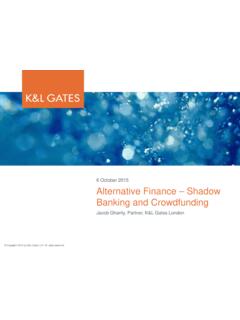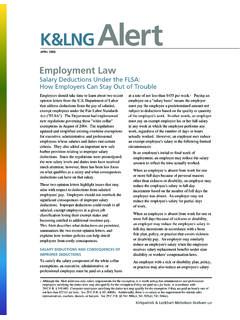Transcription of Major Construction Projects - K&L Gates
1 Major Construction Projects Key Risk and Insurance Strategies January 17, 2012 Houston, TX. Hosted By: John R. Cunningham, Senior Vice President, Marsh Risk Consulting, Construction Consulting Practice Richard F. Paciaroni, Partner, K&L Gates LLP. Speakers Harold Dorbin Michael D. Hastings Josh M. Leavitt Senior Vice President project Risk Practice Leader Partner Marsh Risk Consulting, Marsh Construction K&L Gates LLP. Construction Consulting Practice Practice Bertil C. Olsson Daniel G. Rosenberg Energy, Mining and Partner Power Practice Leader K&L Gates LLP. Marsh 1. Insurance in Context: Construction Risk Management Michael D. Hastings, Marsh Construction Practice Bertil C. Olsson, Marsh Energy, Mining and Power Practice 2. Insurance in Context Risk Transfer is Not Risk Management Charles De Gaulle International Airport, Terminal 2E.
2 May 23, 2004, 05:00 GMT. 3. Insurance in Context What Insurance Can and Can't Do Not all risk is insurable There is an interplay between insurable and uninsurable risk Regardless of insurance in place, loss avoidance and mitigation are preferable to an insurance settlement Insurance can remove barriers to collaboration Insurers provide their best terms and conditions to Projects where risk is managed 4. Insurance in Context Consider/Anticipate all Stakeholders Owners Equity Investors/Partners Lenders Engineering, Procurement and Construction (EPC) Contractors Engineers Trade Contractors Insurers Original Equipment Manufacturers (OEM's). 5. Insurance in Context Construction Risk Management Identify/Quantify the risk to all stakeholders Determine the most effective methods to control and mitigate risk Assign/Define contractual responsibilities Determine the coverage and limits necessary to protect the parties and the work Identify which party is in the best position to provide each coverage Communicate/Collaborate 6.
3 Insurance challenges Market Conditions Market Capacity Offshore Projects Largest Projects exceed market capacity project values > $7 billion Up to $3 billion from conventional markets Potential additional capacity from Oil Insurance, Ltd. (OIL), captives and international reinsurers Delay in Start-up, US Named Windstorm drastically less Market Capacity Onshore Projects project Estimated Maximum Loss (EML). EML typically does not exceed market capacity Up to $4 billion from conventional markets Potential additional capacity from OIL, captives and international reinsurers Delay in Start-up, National Catastrophe (Nat Cat) drastically less Nat Cat Exposures Insufficient market capacity for large project EML. 7. Insurance challenges Issues Affecting Availability Duration of project may be up to 5 + years Experience of contractors/EPC.
4 - New territories different firms/personnel - Quality Assurance/Quality Control (QA/QC) procedures and monitoring thereof New technology and scale-up of existing technology Lenders' expectations - Limits/Deductibles - Scope of coverage - Non-Vitiation Geographic/Geopolitical issues - Availability of spares, installation vessels etc. - Political instability ( Arab spring ). 8. Coverage Issues by Type of project Offshore Projects New WELCAR 2011 form, top issues: Old form insured project from start to finish New form insures listed activities subject to scheduled values declared activities vs. project description . No longer notion of innocent assured lower tier subs can breach warranty and void coverage for all, including project owner Change from a true All Risks policy to a Risks policy shifting burden of proof to assured Likely to be revised, old form still available BUT WELCAR 2011 demonstrates market direction Delay in Start-Up Extremely expensive, lack of capacity Dual trigger features 9.
5 Coverage Issues by Type of project Onshore Defects Coverage London Engineering Group (LEG). clauses Force Majeure Testing time limitation (number of days) as opposed to following project schedule Damage to existing plant 10. Coverage Issues Other Professional Liability - $100 million or more market capacity ( project specific). - Standard of care - Defense erodes limit - LEG coverage - Cost - Forms (Practice, project Professional, Owner's Protective Professional Insurance (OPPI), Contractor's Protective Professional Insurance (CPPI)). Efficacy Insurance - 1990's - 2011. - Renewable energy Projects - First-of-kind technology 11. Legal Perspectives on Construction Insurance Issues Part 1. Josh M. Leavitt, K&L Gates LLP. 12. Delivery System and Insurance Choices Should Be Coordinated 13.
6 Delivery System and Insurance Choices Should be Coordinated Design Build and EPC may provide single source and turnkey responsibility, but owners will still want to be sure downstream coverages are adequate. Collaborative systems and processes such as Integrated project Delivery ( IPD ) and even Design Build, enabled by tools such as Building Information Modeling ( BIM ), may minimize errors, but they also blur project roles making insurability of certain risks problematic. Use of highly capitalized design builders tends to decrease the need for project -specific policies and increases options to use relatively small but highly specialized designers. 14. Delivery System and Insurance Choices Should be Coordinated (continued). Public Private Partnerships may entail substantial and sometimes unrealistic insurance program demands by sponsors and lenders.
7 Construction Management involves provision of professional services that requires professional liability coverage. 15. Key Risk Allocation Provisions: Their Negotiation and Insurability 16. Guarantees and Turnkey Provisions Owners seeking to aggressively pass through all risks must consider the risk premium ramifications. Design builders accepting broad risks must remember that not all risks are insurable even with risk adverse, belts- and suspenders-type insurance programs. A/E's accepting warranty liability or responsibility above and beyond their standard of care may be accepting uninsured risks. 17. Guarantees and Turnkey Provisions (continued). Negotiation points include: Who bears the risk of errors in process designs, performance specifications or other design elements supplied by the owner?
8 Have the engineers providing the process design, performance specifications and detail design all agreed on performance testing and output requirements contained in any warranties? Are limitations of warranties properly expressed? 18. Indemnities Parties must draft around anti-indemnity statutes and still-developing case law. See, for example, the newly enacted Texas anti-indemnity legislation, Texas Insurance Code Section Contractors/A/E's/Design Builders' acceptance of indemnity risks may or may not be insurable depending on the type of coverage and exclusions. Negotiation points include: Who is indemnified? Who is responsible for losses caused by non-parties to the indemnity agreement? Are indemnified claims limited to bodily injury and property damage or do they include economic loss?
9 19. Indemnities (continued). Are there limits on the indemnity's applicability to bad faith claims? Do indemnified attorneys' fees include expert fees, testifying and investigation costs and other types of expenses? Does the indemnified party retain choice of counsel, claims handling and settlement rights? Is indemnity language for environmental, intellectual property and other risks which often appears in separate provisions coordinated with language in the main indemnity provision? 20. Liability Limitations and Consequential Damage Waivers Parties negotiating the allocation of consequential damages risks should be aware of legal definitions of consequential damages. Parties negotiating retrofit, upgrade, divided, or adjacent property Projects should consider what consequential damages may occur to the base or adjoining plant.
10 A/E's should be cognizant of developing case law regarding the unenforceability of extreme liability limitations. What consequential damages risks are insurable under CGL, professional liability and builders risk policies? 21. Liability Limitations and Consequential Damage Waivers (continued). Negotiation points: Are consequential damages defined? How? When is a mutual consequential damage waiver ever favorable to an owner? Are there alternatives to limitations on waivers, such as limiting consequential damages to the extent of insurance coverage, carve-outs for willful conduct, caps, and non-waivers for subcontractor consequential damages? 22. Scheduling, Force Majeure and Delay/Disruption Damages Provisions Owners and upstream parties seeking to limit delay and disruption claims must draft around case law and statutory limits on enforceability of no-damages-for- delay and similar clauses.










